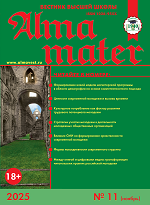Vladimir V. Sviridov ,
Dr. Sci. (Phys.–Math.), professor,
Institute for Management, Marketing and Finance, Voronezh, Russia
E-mail: sviridov@immf.ru
Marina V. Kochukova
Assistant,
Nikolay Burdenko Voronezh State Medical Academy
E-mail: mvko@inbox.ru
Problems in traditional approach to checking of residual knoledges with the help of testing method are revealed. Presented is methodics for elaboration of test tasks’ banks, based on a system approach. On the basis of authors’ estimations in forgetting rate, shown is a preference for using of system tests for checking of residual knoledges of students.
Key words: testing, residual knowledges, test tasks’ banks, system approach, forgetting rate.
References
1. Gosudarstvennye obrazovatel’nye standarty v sisteme obshchego obrazovaniia. Teoriia i praktika. — M.: MPSI Publ., and Voronezh: NPO MODEN Publ., 2002. — 147 p.
2. Standarty i rekomendatsii dlya garantii kachestva vysshego obrazovaniia v evropeiskom prostranstve. — Yoshkar-Ola, 2008. — 58 p.
3. Avanesov, V.S. Teoriia i praktika pedagogicheskikh izmerenii (materialy publikatsii v otkrytykh istochnikakh i internete). Ekaterinburg: ZT & MKO UGTU-UPI Publ., 2005. — 98 p.
4. Kochukova, M.V., Sviridov, V.V., and Tkachyova, N.M. Sistemnyi podkhod k razrabotke soderzhaniia baz testovykh zadanii dlia proverki ostatochnykh znanii // Izvestiia Ural’skogo otdeleniia RAO. — 2009. — No. 11 (68). — P. 31—40.
5. Novaya filosofskaya entsiklopedia. — [URL]: http://iph.ras.ru/enc.htm
6. Efremova, N.F. Sovremennye test tekhnologii v obrazovanii. — M.: Logos, 2003.
7. Plotinskii, Iu.M. Modeli sotsial’nykh protsessov. — M.: Logos, 2001. — 176 p.
8. Ebbinghaus, H. Memory: A contribution to experimental psychology. — N.-Y.: Dover, 1964.
9. White, G.K. Forgetting functions // Animal Learning & Behavior, 2001. — No. 29 (3). — P. 193—207.











.png)






